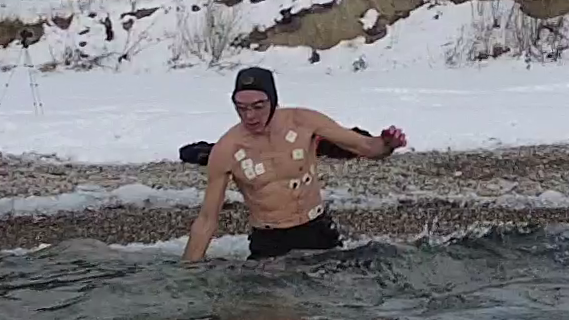Context-aware heart monitor senses ECG + brain + world


Wearables provide a unique opportunity in healthcare, so I am proposing a
context-aware heart monitor that captures full ECG together with a
brain monitor (BlueberryX.com) and an environment monitor (temperature,
live video from surroundings, sound, etc.) so that using machine intelligence
we can learn and understand the heart in-context, i.e. in relation to the
activities being performed, both physical and mental.
The video camera with machine learning will give us a good idea of the
activities being performed as well as the environmental factors like stress
both physical and mental (e.g. crowds, confusion, dangers, traffic, etc.).
The brain monitor will give a good idea of the mental stresses that are being
faced. Together this will give us a new research direction in total
cardiac monitoring.
Dataset: swimop2021feb17 = SwimOP (Swim at Ontario Place) 2021 February 17th
I built an underwater housing for a heart monitor and turned it on and then
sealed it up around 12noon. I then tested my ECG electrodes on a CRO
(Cathode Ray Oscillograph), specifically, HP1200A DUAL TRACE OSCILLOSCOPE,
to pick suitable electrodes from those that were still on my chest from an
emergency room visit Fri 2021 Feb 12th (3M rectangular electrodes).
I chose the two that were the most directly below my left nipple,
probably the ones you might call "V4" and "V5".
The ECG data is in ecg_data_EXG_12.COG
and I wrote a simple Octave (or Matlab) m-file to read it: ecg_data_reader.m
The video from my Wearcam™ (wearable camera)
is UTC (GMT) timecode.
Patient info:
I run and swim year-round nearly every day that it is safe to do so,
and have been for many years. Running and
cold water swimming are well-known as excellent forms of exercise for heart
health. For many years I've been on the following diet: No alcohol, no added
sugar (no desserts, candies, cookies, or cakes, etc.), no processed snack foods,
no white bread, no white rice.
Thurs. Jan 28th I awoke with chest pains which persisted for a couple of weeks
and worsened on the morning of Fri. Feb. 12, along with tingling and numbness
of the left arm, so I went to Toronto General
Hospital emergency department and received the following diagnosis:
"Sinus bradycardia; RSR' or QR pattern in V1 suggests right ventricular conduction delay; Possible Brugada type pattern".
Initial exploration:
Let's initially explore a "wearables dashboard" that overlays ECG onto the
video.
Your job, should you choose it, is to design and implement (prototype) an
augmented reality overlay onto this data that shows heart rate, together with
ECG waveform, and other data, overlaid onto the video.
It would be nice to see the ECG waveform running across the entire width of the
screen, e.g. along the top or bottom.
You might want to have a blackground (black background) border around the video
so the waveform can be displayed as a bright green glow, as this mimics the
original cathode-ray oscillograph or SWIM view (glowing green on a blackground),
like you see here (walls painted black, room dark, etc.):

The glowing green trace on a dark background combined with live video
synchronized to it will provide both an compelling artistic effect as well as
a useful and familiar scientific diagnostic (i.e. something both the public
and medical experts will be familiar with and relate to).
Subsequently let's explore AI and machine learning for realtime cardiac feedback
to the patient AND cariologist along with automated notes, etc..


